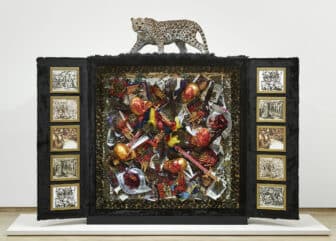
The Border Is Non-Binary: Leslie Martinez and the Fluidity of Form

American painter Leslie Martinez is from the very edge of the US-Mexico border, effectively “right on the river.”1 A native of South Texas’s Rio Grande Valley, Martinez has long been preoccupied with borders—how they are characterized and described, how they function, and ultimately what they are and do as constructs, frameworks, and sites. The late Chicana scholar and queer feminist Gloria Anzaldúa argued that queer and otherwise othered Mexican Americans engender a cultural mestizaje through which we are constantly crossing into and between different worlds: the ethnic home world, the Eurocentric world of the academy, the straight world, the professional world, queer and trans worlds plural, and various communities of color.2 To Martinez and those of us from the borderlands, Anzaldúa’s characterization is as familiar as corn in a cup: the United States and Mexico merge to form a “third country”—border culture—“where the Third World grates against the first and bleeds.”3
Martinez’s artistic practice, in some respects, embodies this complicated and often contested third space. Their paintings—richly textured and intensely colorful works whose surfaces are defined by three-dimensional impasto in the form of painted rags, fabrics, and materials—are characteristically abstract, both in terms of their nonrepresentational and material compositions and their unwillingness to concretize form into meaning. In Martinez’s work, all contexts are open, formless, amorphous, unlimiting, unanchored, fluid: the border is open. The artist’s painting process begins with selecting materials from bins of fragments that have been cut off and gathered from previous paintings. Like baking from a sourdough starter, each new work is the product of all the work before it, and it will make possible all the work that follows.4 In this way, the paintings belong to a kind of generational lineage which perpetuates itself in the process. The resulting works are wildly chromatically and texturally diverse, with undulating waves of painted and oxidized materials swelling and gathering three-dimensionally across the glinting, gnarled surface of the canvas—a rich, fabric impasto.
“I try not to look at myself like a composer or an absolutist,” Martinez explains. “It’s almost like the work is telling me something and I’m going to follow it. There’s a tenderness to it, which I think is extremely queer. You’re letting that thing be what it’s trying to be instead of forcing so much control over it, instead of trying to make it something it’s not.”5 This question of imposing force is not only central to the geographic identity of the US-Mexico borderlands, historically contested territory since the Mexican-American War of the mid-nineteenth century, but also to the identities and freedoms of queer, Two Spirit, and gender-nonconforming people.
A cornerstone of Martinez’s 2023 MoMA PS1 solo exhibition, The Fault of Formation, is an astonishing seven-panel corner painting, The Reconstitution of Rejected and Refracted Voids (2023)—a PS1 commission and the artist’s largest work to date, measuring roughly seven by thirty-five feet.
The painting combines Martinez’s trademark “starter” technique with a scale previously unmatched in their work, marking the first time Martinez has used materials such as Mylar balloons and iron silicate, a copper byproduct used as a blasting abrasive and a material common to construction sites. Equally fierce and dull fuchsias, violets, polleny yellows, high-key oranges, and butane hot blues bubble and ripple across the uneven surface of the work. Rather than rely on the existing architectural support of the gallery corner, this large, multipanel painting extends three-dimensionally into the room, with four panels affixed to one wall and the adjacent three extending to meet the other wall at a point. It is a corner piece that appears to resist the corner. Put another way, the work is quite literally bent.
The painting’s large panels demanded an intensive and taxing physical process to create, and as such the artist’s mother, father, and sister assisted Martinez in building stretchers, stretching canvas, and performing touch-ups on the work with the artist in their Texas studio. Each panel now resides in a different location with a different individual but can be rejoined if necessary. Thereby, the artist invites family, legacy, labor, and modularity into the work and the material context of its existence.6 In this way, Martinez’s corner painting resists several painting conventions, from the work’s origins in familial labor to its “generational lineage” from previous paintings, to its display and geographic distribution among multiple collectors and caretakers. The work exceeds the traditional limits placed upon painting, and therefore it refuses categorization in the same way that the border cannot claim a right to any one territory.
Conversations about the US-Mexico border often have to do with crossing, however it is seldom understood in the broader American cultural imaginary as a dialectical space, as a site of both limitation and limitless possibility. The border—created by men to demarcate and delineate, to separate—resists the binary outcome of falling neatly into one territory or another; it is simultaneously both and neither. The border is non-binary.7 Its fluidity is evident in the water that flows from the Rio Grande to the Gulf of Mexico, and in the cultural fluidity of the communities along its banks. Anzaldúa, a lesbian Chicana feminist scholar from Harlingen, Texas and the daughter of a tenant farmer and sharecropper from the Rio Grande Valley, either coined or clocked the concept of nonbinary gender, what she called mita’ y mita’ or “half and half” in her 1987 book Borderlands/La Frontera: The New Mestiza. She writes:
There is something compelling about being both male and female, about having an entry into both worlds. Contrary to some psychiatric tenets, half and halfs are not suffering from a confusion of sexual identity, or even from a confusion of gender. What we are suffering from is an absolute despot duality that says we are able to be only one or the other. It claims that human nature is limited and cannot evolve into something better. But I, like other queer people, am two in one body, both male and female. I am the embodiment of the hieros gamos: the coming together of opposite qualities within.8
Anzaldúa’s argumentation makes accommodations for a “third country” of nonbinary gender, where cisgender people grate against each other and bleed. The Reconstitution of Rejected and Refracted Voids, Martinez’s mammoth seven-panel corner painting, particularly embodies this borderland third space—a site of transition, resistance, shared experience, and familial and physical labor. The painting’s reluctance to resolve its overlapping and opposing truths—surface and support, subject and speaker, successor and starter, offspring and mother—places it in dialogue with Anzaldúa’s concept of mita’ y mita’, in so much as the work explicates the ‘half and half’ or ‘both/and’ dynamics that in many ways define the borderland. As with the “third country” of border culture, the work is both painting and sculpture, and neither; both abstraction and something defiantly more meaningful.
The rhetoric around the US-Mexico border has intensified in recent years as an inherent part of an ever-expanding globalizing project of xenophobia fueled by billionaire-funded culture wars, the collapse of Western democracy, the corruption of empire, land theft, the economic incentives of war and genocide, and growing displacements caused by a worsening climate crisis. The implications of these conflating crises are all at stake in Martinez’s work, concealed by the veneer of abstraction. In The Reconstitution of Rejected and Refracted Voids, Martinez makes material space for more meaning, widening and expanding borders rather than merely traversing them; their painting is engaged in the practice of being a border.9 In Martinez’s careful and skilled hands, painting and gender and meaning represent contestations of form and borderlands perpetually in dispute.
- Leslie Martinez, virtual conversation with the author, November 22, 2024. ↩︎
- Ellie Hernández, “Re-Thinking Margins and Borders: An Interview with Gloria Anzaldúa,” Discourse 18, no. 1/2, Remapping the Border Subject (Fall/Winter 1995–96): 9. ↩︎
- Gloria Anzaldúa, Borderlands/La Frontera: The New Mestiza (Aunt Lute Books, 1987), 3. ↩︎
- In this way, the work is perpetually reproducing asexually through fragments of itself, like bacteria or the academy.
↩︎ - Leslie Martinez, phone conversation with the author, January 29, 2025. ↩︎
- Elena Ketelsen González, extended object label and interpretive materials for The Reconstitution of Rejected and Refracted Voids (2023), in Leslie Martinez: The Fault of Formation, MoMA PS1, November 16, 2023–April 8, 2024. ↩︎
- Martinez, virtual conversation, November 22, 2024. ↩︎
- Anzaldúa, Borderlands, 19. ↩︎
- See Nuit Banai, Being a Border (Dublin: Paper Visual Art and National College of Art and Design, 2021). ↩︎
Evan Garza is a global contemporary art scholar, queer art historian, a recent Fulbright Scholar, and curator at MASS MoCA in North Adams, Massachusetts. They earned their MA from the Williams Graduate Program in the History of Art at the Clark Art Institute.
Cite this essay: Evan Garza, “The Border Is Non-Binary: Leslie Martinez and the Fluidity of Form,” in X as Intersection: Writing on Latinx Art, October 29, 2025, accessed [DATE], https://uslaf.org/essay/the-border-is-non-binary-leslie-martinez-and-the-fluidity-of-form/



